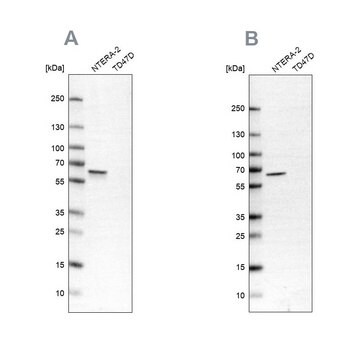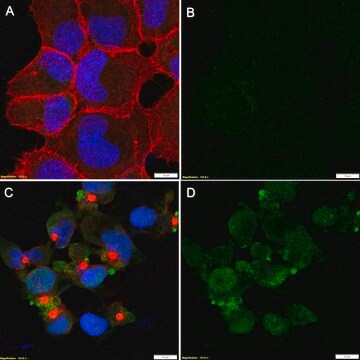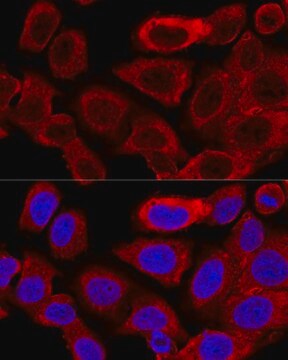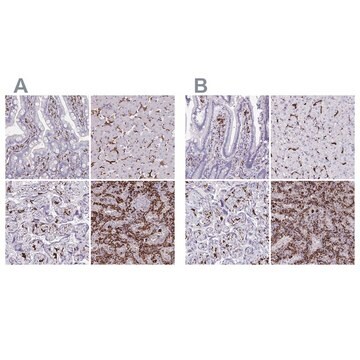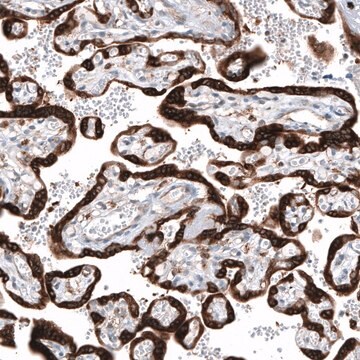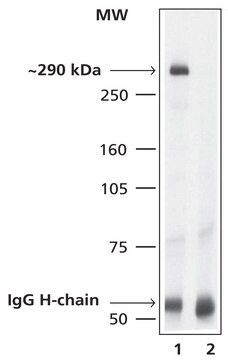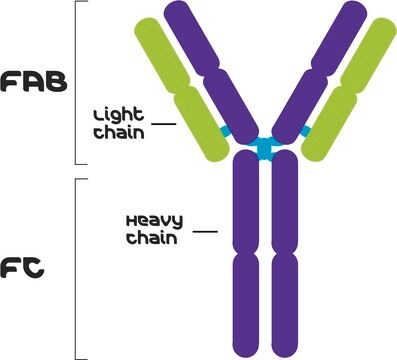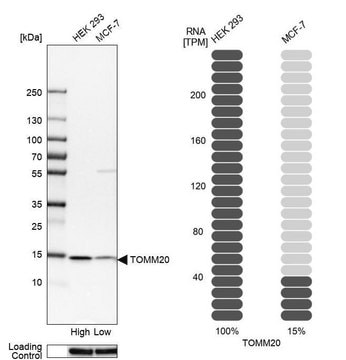추천 제품
생물학적 소스
rabbit
결합
unconjugated
항체 형태
affinity isolated antibody
항체 생산 유형
primary antibodies
클론
polyclonal
제품 라인
Prestige Antibodies® Powered by Atlas Antibodies
양식
buffered aqueous glycerol solution
종 반응성
mouse, rat, human
기술
immunoblotting: 0.04-0.4 μg/mL
immunohistochemistry: 1:200-1:500
면역원 서열
AKKLDKENLSDERASGQSCTLPKRSDSELKDEKPKRPEDESGRDYREREREYERDQERILRERERLKRQEEERRRQKERYEKEKTFKRKEEEMKKEKDTLRDKGKKAESTESIGSSEKTEKKEEVVKRDRIRNKDR
UniProt 수납 번호
배송 상태
wet ice
저장 온도
−20°C
타겟 번역 후 변형
unmodified
유전자 정보
human ... UPF3B(65109)
유사한 제품을 찾으십니까? 방문 제품 비교 안내
면역원
Regulator of nonsense transcripts 3B recombinant protein epitope signature tag (PrEST)
애플리케이션
All Prestige Antibodies Powered by Atlas Antibodies are developed and validated by the Human Protein Atlas (HPA) project and as a result, are supported by the most extensive characterization in the industry.
The Human Protein Atlas project can be subdivided into three efforts: Human Tissue Atlas, Cancer Atlas, and Human Cell Atlas. The antibodies that have been generated in support of the Tissue and Cancer Atlas projects have been tested by immunohistochemistry against hundreds of normal and disease tissues and through the recent efforts of the Human Cell Atlas project, many have been characterized by immunofluorescence to map the human proteome not only at the tissue level but now at the subcellular level. These images and the collection of this vast data set can be viewed on the Human Protein Atlas (HPA) site by clicking on the Image Gallery link. We also provide Prestige Antibodies® protocols and other useful information.
The Human Protein Atlas project can be subdivided into three efforts: Human Tissue Atlas, Cancer Atlas, and Human Cell Atlas. The antibodies that have been generated in support of the Tissue and Cancer Atlas projects have been tested by immunohistochemistry against hundreds of normal and disease tissues and through the recent efforts of the Human Cell Atlas project, many have been characterized by immunofluorescence to map the human proteome not only at the tissue level but now at the subcellular level. These images and the collection of this vast data set can be viewed on the Human Protein Atlas (HPA) site by clicking on the Image Gallery link. We also provide Prestige Antibodies® protocols and other useful information.
생화학적/생리학적 작용
UPF3B (UPF3 regulator of nonsense transcripts homolog B) is a nucleo-cytoplasmic shuttling protein. It is expressed in all adult tissues. It shuttles between nucleus and cytoplasmic region. It consists of a conserved domain that participates in interaction with the exon junction complex (EJC) protein Y14. Furthermore, nonsense-mediated mRNA decay (NMD) mechanism is highly dependent on the Y14/UPF3B interaction. In Y14/UPF3B interaction pathway, EJC proteins act as adhering points for the formation of distinguishable NMD-activating mRNPs. For instance, during NMD UPF3B binds to the spliced β-globin mRNA in vivo to eliminate mRNAs containing a premature translation termination codon.
특징 및 장점
Prestige Antibodies® are highly characterized and extensively validated antibodies with the added benefit of all available characterization data for each target being accessible via the Human Protein Atlas portal linked just below the product name at the top of this page. The uniqueness and low cross-reactivity of the Prestige Antibodies® to other proteins are due to a thorough selection of antigen regions, affinity purification, and stringent selection. Prestige antigen controls are available for every corresponding Prestige Antibody and can be found in the linkage section.
Every Prestige Antibody is tested in the following ways:
Every Prestige Antibody is tested in the following ways:
- IHC tissue array of 44 normal human tissues and 20 of the most common cancer type tissues.
- Protein array of 364 human recombinant protein fragments.
결합
Corresponding Antigen APREST74305
물리적 형태
Solution in phosphate-buffered saline, pH 7.2, containing 40% glycerol and 0.02% sodium azide
법적 정보
Prestige Antibodies is a registered trademark of Merck KGaA, Darmstadt, Germany
면책조항
Unless otherwise stated in our catalog or other company documentation accompanying the product(s), our products are intended for research use only and are not to be used for any other purpose, which includes but is not limited to, unauthorized commercial uses, in vitro diagnostic uses, ex vivo or in vivo therapeutic uses or any type of consumption or application to humans or animals.
적합한 제품을 찾을 수 없으신가요?
당사의 제품 선택기 도구.을(를) 시도해 보세요.
Storage Class Code
10 - Combustible liquids
WGK
WGK 1
Flash Point (°F)
Not applicable
Flash Point (°C)
Not applicable
개인 보호 장비
Eyeshields, Gloves, multi-purpose combination respirator cartridge (US)
가장 최신 버전 중 하나를 선택하세요:
Shihua Lu et al.
RNA biology, 1(1), 42-47 (2006-12-30)
The subcellular localization of the nonsense mediated decay (NMD) of mRNA transcripts bearing premature termination codons has been controversial. Recently, it has been demonstrated that RNA tethering of key mediators of NMD, including human UPF3B, accurately recreates NMD. Here, we
Niels H Gehring et al.
Molecular cell, 20(1), 65-75 (2005-10-08)
Messenger RNAs (mRNAs) bearing premature translation termination codons (PTCs) are degraded by nonsense-mediated mRNA decay (NMD). For mammalian NMD, current models propose a linear pathway that involves the splicing-dependent deposition of exon-junction complexes (EJCs) and the sequential action of the
Hala Chamieh et al.
Nature structural & molecular biology, 15(1), 85-93 (2007-12-11)
Nonsense-mediated mRNA decay (NMD) eliminates mRNAs containing a premature translation termination codon through the recruitment of the conserved NMD factors UPF1, UPF2 and UPF3. In humans, a dynamic assembly pathway allows UPF1 to join UPF2 and UPF3 recruited to the
Joachim B Kunz et al.
RNA (New York, N.Y.), 12(6), 1015-1022 (2006-04-08)
The exon-junction complex (EJC) components hUpf3a and hUpf3b serve a dual function: They promote nonsense-mediated mRNA decay (NMD), and they also regulate translation efficiency. Whether these two functions are interdependent or independent of each other is unknown. We characterized the
Niels H Gehring et al.
Molecular cell, 11(4), 939-949 (2003-04-30)
Messenger RNAs with premature translation termination codons (PTCs) are degraded by nonsense-mediated mRNA decay (NMD). In mammals, PTCs are discriminated from physiological stop codons by a process thought to involve the splicing-dependent deposition of an exon junction complex (EJC), EJC-mediated
자사의 과학자팀은 생명 과학, 재료 과학, 화학 합성, 크로마토그래피, 분석 및 기타 많은 영역을 포함한 모든 과학 분야에 경험이 있습니다..
고객지원팀으로 연락바랍니다.